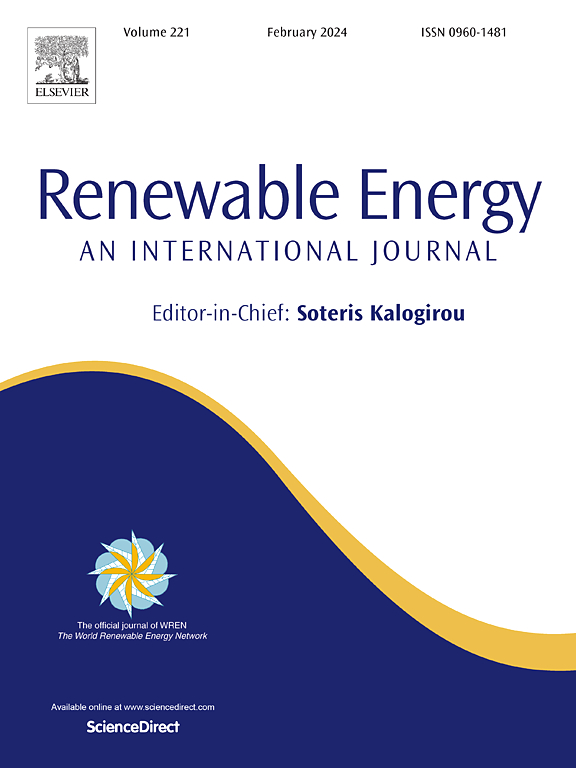Sand particle deposition and re-suspension characteristics of PV modules and the effects on PV efficiency: based on CFD-DEM simulation
IF 9.1
1区 工程技术
Q1 ENERGY & FUELS
引用次数: 0
Abstract
Solar energy, as a kind of important renewable energy source, has been developed rapidly in recent years. However, the efficiency of photovoltaic (PV) power generation is not high due to particle deposition, especially in desert area. For better understanding the dust deposition and re-suspension characteristics of PV modules, a multi-physics field model considering particle deposition and re-suspension is developed using a coupled CFD-DEM method. The processes of collision, rolling, deposition, bounce and re-suspension of particles on the PV module are considered in the simulation. A total of 20 kinds of cases are developed in the simulation. The results show that the sand particles located around the PV panels are firstly removed after wind blowing. Vin = 5.2 m/s, can effectively clean particles with dp ≤ 200 μm, removal rate δ ≥ 42.3 %. Vin = 7.8 m/s can effectively clean particles with dp ≤ 500 μm, and the removal rate δ ≥ 50.6 %. And the reduction of PV efficiency varied significantly with increasing inlet velocity, Vin = 2.6, 5.2, 7.8 m/s, η is 6.60 %, 5.61 % and 2.86 %, respectively. For particle size with 100 μm ≤ dp ≤ 500 μm, evaluated by PV maximum output power, a higher inlet velocity leads to a better removal effect, particularly for larger sand particles. Based on the reduction of PV efficiency evaluation, it is shown that the larger the inlet velocity, a smaller particle size leads to a smaller η value and the a cleaning effect.
光伏组件的沙粒沉积和再悬浮特性及其对光伏效率的影响——基于CFD-DEM模拟
太阳能作为一种重要的可再生能源,近年来得到了迅速的发展。然而,由于颗粒沉积,光伏发电效率不高,特别是在沙漠地区。为了更好地理解光伏组件的粉尘沉积和再悬浮特性,采用耦合CFD-DEM方法建立了考虑颗粒沉积和再悬浮的多物理场模型。模拟中考虑了颗粒在光伏组件上的碰撞、滚动、沉积、弹跳和再悬浮等过程。在仿真中共开发了20种情况。结果表明:风吹后,光伏板周围的沙粒首先被去除;Vin = 5.2 m/s,可有效清洗dp≤200 μm的颗粒,去除率δ≥42.3%。Vin = 7.8 m/s可有效去除dp≤500 μm的颗粒,去除率δ≥50.6%。随着进口速度的增加,PV效率的降低幅度显著,Vin = 2.6、5.2、7.8 m/s, η分别为6.60%、5.61%和2.86%。对于粒径为100 μm≤dp≤500 μm的颗粒,以PV最大输出功率评价,入口速度越高,去除效果越好,特别是对于较大的颗粒。通过对PV效率评价的降低,表明进口速度越大,粒径越小,η值越小,净化效果越好。
本文章由计算机程序翻译,如有差异,请以英文原文为准。
求助全文
约1分钟内获得全文
求助全文
来源期刊

Renewable Energy
工程技术-能源与燃料
CiteScore
18.40
自引率
9.20%
发文量
1955
审稿时长
6.6 months
期刊介绍:
Renewable Energy journal is dedicated to advancing knowledge and disseminating insights on various topics and technologies within renewable energy systems and components. Our mission is to support researchers, engineers, economists, manufacturers, NGOs, associations, and societies in staying updated on new developments in their respective fields and applying alternative energy solutions to current practices.
As an international, multidisciplinary journal in renewable energy engineering and research, we strive to be a premier peer-reviewed platform and a trusted source of original research and reviews in the field of renewable energy. Join us in our endeavor to drive innovation and progress in sustainable energy solutions.
 求助内容:
求助内容: 应助结果提醒方式:
应助结果提醒方式:


